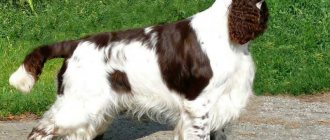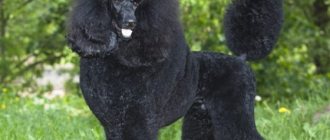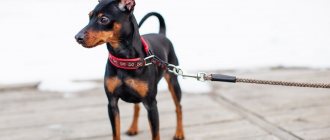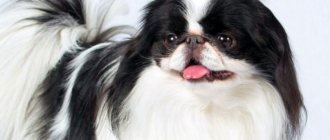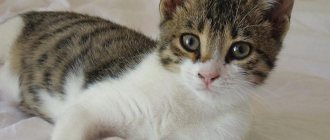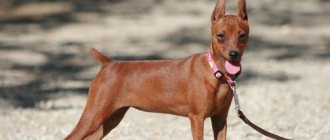Brief characteristics of the breed
Males:
Bitches:
What is the price:
Life expectancy: 10-15 years. |
How is a miniature poodle different from a miniature poodle? | The small (or medium) is larger than the dwarf, the height at the withers is up to 35-45 cm. It is more hardy, but less mobile than the dwarf. |
Is it true that poodles do not shed and do not have the characteristic dog smell? | Indeed, they do not leave fur behind and are perfect for keeping in an apartment. The hair, of course, falls out, but in small quantities, and remains on the poodle. Regular care, including washing and cutting, can remove it. The poodle does not smell like a dog due to inactive sebaceous glands. Its fur will have an odor depending on the conditions of its detention. Please note that the sebaceous glands do not work well only in purebred individuals. |
Can dog fur cause allergies? | This is the most suitable dog for those who suffer from allergies. To prevent allergens from accumulating, you will need to wash your pet once every day. in 10-14 days. It is recommended to use special hypoallergenic cosmetics. |
Is it difficult to train? | No. This is the easiest breed to train. These are the dogs that most often take part in circus performances. They love to learn, they like to bring joy to their owner. |
Who are they suitable for? | Most suitable for people leading a measured lifestyle, pensioners, children over 7 years old, due to the characteristics of the animal’s intelligence and temperament. |
Who is better to choose: a girl or a boy? | Males are more temperamental. Bitches have a calm character and are more attached to their owner. There are some differences in care: you will have to walk a male dog longer, as he tends to mark his territory. The bitch goes into heat twice a year, and then you will only have to walk her on a leash, away from other dogs. If you plan to take part in exhibitions, it is better to take a male, since females lose their shape after giving birth and lactation for several months. |
Who is this dog breed not suitable for? | Homebodies, quiet people who love silence, as well as very young children. Because of the child’s mischief, the dog may experience stress or will not tolerate it calmly. |
Advantages of the breed
- They have an original appearance and lively temperament.
- They are not aggressive towards cats or other dogs, they are playful, and are suitable for any family.
- Its small size allows you to keep a dog even in a small apartment.
- They don't shed, don't smell like dog, and don't cause allergies.
- These are loyal, very easy-going pets that get along well with children.
- Very smart. In terms of intelligence, they are in 2nd place (collies are in 1st place).
- They are extremely trainable.
- The characteristics of the Miniature Poodle breed include good guarding qualities. “Dwarves” are wary of strangers and bark in defense of their owner and their own territory.
Disadvantages, difficulties in care
- Nervous, excitable. They tend to bark a lot and for a long time, especially at a young age. Any sounds can become an irritant.
- Some representatives of this breed are timid and fearful.
- They may react sharply to loud voices and emotional tension in the family. Animals tolerate stress very poorly, which can cause gastrointestinal disorders and nervousness.
- The pet cannot be left alone for a long time; it cannot stand loneliness and suffers from lack of attention.
- The coat requires special care; it needs to be combed and trimmed regularly. In addition, the animal must be washed frequently.
- A disadvantage for calm people who love silence may be the mobility of the pet. “Dwarves” are almost always constantly on the move, running, jumping, and playing a lot.
- Since these dogs need to move a lot, walking should be intense (at least 1 hour a day). If physical activity is not enough, the pet will bark a lot, chew things, and may become aggressive.
Varieties of colors
The standard for representatives of the dwarf poodle breed allows several solid colors: black, apricot, peach, brown (any shade), silver (gray) or white. Since 2007, the color has been recognized as brown-red (red).
In the Russian Federation and a number of other countries, the tan color (phantom) and harlequin are adopted as standard. Miniature poodles with such a rare color are more expensive than solid ones.
Photo of a miniature poodle
Possible diseases and methods of treating them
Unfortunately, representatives of this breed are sickly. Doctors discover cataracts or otitis media in almost every poodle at the end of its life. Genetically, such dogs are predisposed to many eye and ear diseases. They cannot be treated without professional help.
Also common among them are: hip dysplasia, osteochondrosis, diabetes mellitus and other diseases. In dogs that suffer from ailments of the joints and muscles, coordination of movements is impaired. They should not be exhausted by stress; it is better to create comfortable conditions for home rest.
But those who are faced with diabetes or allergies will have to follow a diet. Less commonly, toy poodles are diagnosed with cancer. If malignant tumors are detected early on the surface of dog organs, it is possible to save them in an operable manner.
Character, behavioral characteristics
Dwarf (miniature) poodles are quite hardy, cheerful, and playful. They are very active, sociable, and love attention. Loneliness is destructive for them. These dogs are very sensitive and require careful handling and delicacy.
Learning abilities
Sociable, easy to learn. They are very demanding of attention and accept any manifestations of it, including training, with joy. Dogs of this breed are very smart, they understand everything perfectly and can quickly master many commands. It should be borne in mind that harsh training is unacceptable; the poodle requires a polite attitude.
It is very important to start training in a timely manner, since the pet quickly develops such a character trait as perseverance. He will often act in his own way, this behavior will be very difficult to change.
Attitude towards the owner, strangers, other animals
These dogs have very developed empathy - the ability to empathize, they subtly sense the mood of the owner. This is a true companion, quickly acquiring those behavioral characteristics that are more interesting to the owner.
The Miniature Poodle will be a good friend for children over 7 years old, as they love to play. However, if the child is overly aggressive, there is a risk that the animal will develop mental health problems. This breed is not suitable for small children.
"Dwarf" can sometimes be jealous of the owner of other pets. He is more comfortable in the company of people than in the company of animals. Sometimes he shows fear and caution towards strangers, but not aggression, but he can bark at strangers. The dog will always react to any noise outside the door by barking.
Behavior and skills
Dogs of this breed are characterized by tirelessness and activity. At the same time, miniature poodles are incredibly elegant and full of self-esteem. If you immediately begin to instill in them the necessary skills, then the animals are particularly attentive and obedient.
Kids are very sensitive to their owner’s emotions and are unobtrusive. Puppies quickly adapt to the interests, routine and rhythm of life of the family.
Care
Care and maintenance of a dwarf poodle has its own peculiarities.
- Bathing: at least 1 p.m. per month or as pollution occurs. If the procedure is regular, it will take less time, since the hair will not roll off. Before bathing, place cotton swabs in the dog’s ear canals, which must first be moistened with petroleum jelly.
- Combing with a stiff brush: daily. It replaces massage and improves blood circulation.
- Haircut: at the groomer or at home (using a clipper) - at least 1 p.m. at 2 months
- Ear care: regular checkups. If you notice discharge or an unpleasant odor, you should take the dog to the veterinarian.
- Eyes: examination, rinsing with warm water, weakly brewed tea. The following symptoms require contacting a veterinarian: tearing, redness, signs of souring.
- Teeth: keeping clean, dental cleaning.
- Paws: wash after every walk. Inspect for cracks and damage.
- Nail care: trim with a nail clipper 1-2 times a month. followed by filing.
- Vaccinations: the main one is against plague and parvovirus at the age of 6-8 weeks. Revaccination – after 2-3 weeks. In 10 days before vaccination – deworming, flea and tick treatment. The injection is given only to healthy puppies. If the dog has been ill with something, it can be vaccinated no earlier than after 12-14 days. after recovery. After vaccination, the puppy must be protected from hypothermia; walking is allowed only after 10-12 days.
Origin story
Thanks to their thick, lush coat, poodles have a very decorative and glamorous appearance. However, the ancient breed of dogs has long been considered a hunting dog. The ancestors of modern dwarf poodles had a rougher appearance and good health, they were trained to flush, catch and bring game birds from the water. Through the efforts of breeders, the breed has become one of the most attractive and popular breeds in the world.
The origin of the poodle is not known for certain, but presumably many ancient breeds of herding and hunting dogs with long hair (spaniel, retriever, greyhound, barbet, etc.) took part in it. The name comes from the German “paddeln” (“to splash”), as these animals adore water.
Poodle-shaped dogs have been known since antiquity. Their images on historical artifacts are found everywhere. These are ancient paintings, coins, frescoes, etc. The breed received its name and fame at the end of the 15th century. The Baroque and Rococo eras were the real heyday of dogs. The first description was made in 1555, and 7 years later 3 varieties were identified (large, dwarf, multi-colored).
In the Middle Ages, all types of poodles were popular with the nobility of Europe. And the dwarf species has become so widespread among the French that it has practically become a symbol of the state. Fashion reached Russia only in the 18th century.
They started giving different haircuts and hairstyles to dogs in the 16th century. A significant role in this was played by traveling circus troupes, who wanted to give the four-legged performers a more spectacular appearance. In the 17th-18th centuries, salons for “noble” dogs appeared.
France is considered the homeland of dwarf poodles, since it was there that the breed received the greatest development, and dog handlers around the world recognized the standards developed in this country. England and Germany played a significant role in the promotion and spread of this breed.
A haircut
Grooming your toy poodle can be done at home. Place the dog on the table. For a dog to stand still, it must be on a leash. If this is your first haircut, show the clipper to the animal and let him sniff it. Then simply turn on the device without starting the procedure so that the dog can get used to the unfamiliar object and stop being afraid.
Head and neck haircut
- With one hand, grab the dog by the muzzle, and with the other hand, fold one ear back. While holding the dog, clip the hair with a clipper, drawing a line from the curled ear to the nose, then from the ear to the corner of the eye.
- Trim the fur on the cheek, then above the eye, under the eye.
- Lift the dog's head up and trim the hair on the neck.
- Cut the dog's hair on the other side in the same way.
Paw trimming
- Grasp the dog's paw with your left hand, with your thumb on top. Trim the fur.
- Then you need to remove it from your fingers. Make the dog bend its paw at the ankle. Trim off the fur between the fingertips.
Tail cut
- When cutting the tail, the clipper should move from its base to the end. Leave a pompom at the end of the tail.
- Trim the fur between the hind legs, first lifting the animal's tail.
Belly haircut
- Place the dog on its hind legs, holding it by its front legs. Trim it by pointing the clipper from the navel down the inner thighs to where the fur begins to thicken.
- Trim the belly, lifting the dog's paws one at a time.
Popular haircuts
To achieve a certain haircut, do not remove hair on certain parts of the body.
- "A lion". Trim the back of the body to the level of the ribs. Trim the fur on the face, tail, and paws. Leave the pom-poms on the ankles and tail.
- "Modern". Trim the hair on the face, back (from the withers), and croup. No need for paws. Hair of 1 cm in length is left on the belly and sides.
- "Bikini". The dog should have short hair all over its body. Pompoms are left on the ankles and the tip of the tail.
Photo and video review
A comprehensive description of the breed will be supplemented by photos of dwarf poodles, as well as an interesting and useful video review.
Diseases
Most often identified:
- tearfulness,
- ear infections,
- otitis,
- deafness,
- epilepsy,
- retinal atrophy,
- heart disorders,
- autoimmune anemia,
- diabetes,
- dental problems.
Miniature poodles have a genetic predisposition to narrowed nasal passages. As a result, breathing becomes difficult, wheezing and snoring appear. The problem is eliminated surgically. A defect such as a “cleft palate” (cleft of the hard palate) is often identified.
Due to lop ears, animals are prone to ear diseases (inflammation, ear mite damage). Be sure to ensure that when bathing your pet, no water gets into its ear canals. If this happens, remove it carefully.
To prevent tartar, you need to regularly brush your animal’s teeth using special food and treats. To prevent your pet from developing any pathologies of the cardiovascular system, try not to expose him to stress. Any stress, including psycho-emotional, should be moderate.
A veterinary first aid kit is a must. It should contain:
- thermometer+vaseline,
- cotton wool,
- bandage,
- syringe,
- tweezers,
- eye pipettes,
- rubber tourniquet, hemostatic.
You will also need disinfectants:
- iodine,
- hydrogen peroxide,
- chlorhexidine,
- brilliant green,
- streptocid.
Additionally purchased:
- antispasmodics, painkillers - “No-shpa”;
- antihelminthics - “Azinox”, “Prazid”;
- anti-tick products - “Bars”, “Dana”, etc.;
- cardiac - valerian drops, caffeine;
- remedies for poisoning - activated carbon (Polyphepan, Enterosgel), castor oil, Glauber's salt.
Health and life expectancy
It’s difficult to say for sure how long a pet lives. The average lifespan is 15 years, however, it is not uncommon for poodles to live much longer, but only with proper maintenance, care and disease prevention.
Miniature pets can have many health problems:
- Cataract, glaucoma. Retinal degeneration is a hereditary disease. These pathologies can appear at any age.
- Elderly individuals often experience hip dysplasia and osteochondrosis.
- Possible problems with the thyroid gland. This is fraught with disruption of the functioning of the digestive system.
- There is a risk of developing von Willebrand disease - internal bleeding.
- Poodles are susceptible to cancer, and tumors can develop from both benign etiology and malignant ones.
- If your dog scratches his ears frequently, he probably has otitis media. Since the ears of poodles are close to the head, this creates a favorable environment for the development of bacteria.
- Pets often experience food or skin allergies. The food variety can be recognized by copious discharge from the eyes and nose. The second is characterized by hair loss.
- If your dog is fed low-quality dry food, then over time there is a high risk of developing urolithiasis.
- Degenerative myelopathy is a rare disease, but can also occur. Pathology of a neurological nature, manifested by a muscle defect. When walking, the dog's paws turn under, or even the dog cannot get up at all.
- Male dogs may develop cryptorchidism or prolapse of the testes. The problem can be easily corrected with surgery, but such a dog will no longer be able to participate in further breeding of the breed.
- Hereditary congenital deafness.
Brown toy poodles begin to turn gray early.
Puppies: selection and care
Before choosing a dwarf (miniature) poodle puppy, it is recommended to study the description of the breed. To buy a purebred dog, of course, it is better to contact breeders. Color does not affect the quality of the animal, but the difficulty of care depends on it.
The white dog is very photogenic, but it is more difficult to care for. Whitening shampoos will be needed to remove yellow spots, especially where the coat gets particularly dirty (paws, ears). Less hassle with caring for brown and black dogs.
The white coat may have a slightly creamy tint, which fades with age. However, if the color is apricot or darker, most likely the dog will remain that way. Silver puppies may be black at birth; the silver color appears starting at 6-8 weeks of age.
Do not forget that this is a companion dog, so you need to choose it taking into account your lifestyle and temperament. When examining all the puppies, it is not necessary to give preference to the most active one. An active and lively dog is not suitable for those who like leisurely walks. In this case, it is better to choose a calmer one.
When inspecting, pay attention to the following points:
- the eyes should not become sour or watery;
- there should be no rash on the skin;
- if the tail is dirty, the fur under it is stuck together, then the dog has digestive problems;
- The inside of the ears should be odorless and without any signs of ear mites.
Care
In the first 4 months, the puppy requires more careful care. The optimal air temperature in the room should not be less than 16-18 ºС. The pet needs to be allocated a place - a clean, bright space in the room (not in the kitchen or bathroom), drafts are unacceptable. You can’t place bedding near a battery either. List of required items:
- slicker,
- a comb with long, but not very frequent teeth,
- hair clipper,
- shampoo,
- hair dryer,
- nail clipper, file.
Walking: required for harmonious growth and development. Movement helps the body become stronger. A puppy under 3 months old has not yet strengthened his back, and it is harmful for him to move up stairs. You have to carry him outside in your arms. If you are planning a long walk, you should go out no earlier than an hour after feeding.
Important: these dogs have almost no undercoat and do not tolerate cold well. You need to walk with your puppy at a fast pace; active games will help you warm up. It is recommended to purchase clothes for walking. In order for a dog to adapt to the cold, you need to walk it for 3-4 days. per day for 20-30 minutes, gradually increasing the time to 30-40 minutes. If your pet shows signs of freezing (trembling, clenching its paws), you need to return home.
- Bathing: 1 time per week.
- Combing: daily.
- Haircut: at least 1 p.m. at 2 months
Advantages and disadvantages
The small poodle dog breed has a number of disadvantages:
- The need for careful pet care. Poodles are among the very clean dogs, so their owner will have to devote a lot of time to keeping their pet clean. In this case, we are talking not only about bathing, but also about cleaning the ears, eyes, and trimming the nails. This also includes regular brushing of your pet and monthly haircuts.
- Requires regular physical activity. The Miniature Poodle is a very active dog and will require daily walks.
- If a cat lives in the house, then conflicts are practically unavoidable.
But all these disadvantages are completely offset by a number of advantages:
- The animals are friendly and loyal. They never attack and practically do not bark at strangers unless they pose a danger to their owner.
- Get along well with small children. They are happy to participate in their games, especially if they involve a ball or require swimming.
- They are highly trainable. Thanks to their good memory and complaisance, animals not only quickly remember commands, but also execute them almost at lightning speed.
- The coat of small poodles is hypoallergenic.
Feeding a Miniature Poodle
Age 8-10 weeks.
Feeding frequency: 4-5 r. a day, at the same time.
Ready-made food is given in accordance with the instructions indicated on the packaging. No other food can be fed.
Natural food. During the day you need to alternate between meat and dairy feeding.
Meat: Boil rice, buckwheat. Finely chop the raw meat and scald it with boiling water. You can boil it first. Mix the porridge with meat in a ratio of 1 to 2. Add a small amount of grated apple (or carrots) and sunflower oil. Instead, you can add a little vitamin-mineral mixture (according to the information on the package).
Dairy: Fermented milk products (cottage cheese, kefir), raw or boiled egg yolk. It is allowed to add a small amount of porridge (buckwheat, rice), chopped fruit (banana, apple). The puppy is not allowed milk.
Age 10 weeks. — 4 months
- Feeding frequency: by the age of 4 months. gradually reduce to 3. If your dog asks to eat between feedings, it means he is not getting enough. In this case, feed her 4 times. in a day.
- The composition of the diet is similar.
Age from 4 months. up to six months
- Feeding frequency: 3-4 r. in a day.
- Ready-made feed. Replaced from Puppy to Junior. This should be done gradually, following the manufacturer's instructions.
- Natural food. Some of the meat can be replaced with offal or boiled fish (sea fish), after removing the bones.
Age 6 months - 1 year.
- Feeding frequency: 3-4 r. in a day.
- Ready-made feed. After changing the incisors, switch your pet to adult food.
- Natural food. The composition of the diet is the same. The amount of feed is determined individually, experimentally. The volume of food is calculated in such a way that the dog eats everything without leaving a trace, but does not overeat.
Age from 1 year
- Feeding frequency: 3 times. in a day.
- Ready-made food: in accordance with the instructions on the packaging.
- Natural food. The diet of a miniature poodle under the age of 1.5 years should contain mainly meat - 2/3 of the part. For a pet over 1.5 years old, the amount of meat is reduced to 1/3, porridge, and other food is increased to 2/3.
Raising and training a dog
Training a miniature poodle is not a difficult task, since the breed has high intelligence and a relatively calm temperament. Pet commands are remembered quickly and for a long time. At the first stage, from 2 months, it is necessary to instill in the puppy basic skills (name, toilet, walking on a leash) and teach unquestioning obedience. Otherwise, the animal will begin to ignore training.
A slightly matured dwarf poodle (from 4 months) continues to be trained, observing the sequence of their actions, encouraging and maintaining the pet’s interest in the process. A smart dog will quickly learn to understand the owner at a glance.
Raising a puppy
Remove items that your puppy might chew on. Instead, there should be toys on the floor: balls, branches, etc. The dog must know and flawlessly follow the commands:
- “stop!”, “come to me!”, neglect can lead to disastrous consequences (for example, a dog can get hit by a car by running out onto the roadway);
- “Ugh!”, the command will help teach your pet not to pick up food on the street.
If you plan to participate in exhibitions in the future, you need to teach your pet:
- be calm when examining your teeth;
- show yourself in motion (prancing light gait while maintaining beautiful posture, perky mood, confidence);
- stand correctly (head raised high, hind legs slightly back, tail positioned upwards).
Dog training
The Miniature Poodle is a smart dog that loves attention. The dog may pretend he doesn't care. But representatives of this breed are always happy to demonstrate their skills. It is strictly forbidden to scold a dog during training - pets are very vulnerable. In unfavorable conditions they can become fearful and restless.
High intelligence makes the pet a suitable option for novice dog owners. You can do it on your own, without the help of a professional trainer. Owners claim that some pets don’t even need treats. The main motivation is praise and attention from the owner.
Standards
| Usage | Companion dog |
| Appearance | Proportionally built, with curly or corded coat. |
| Temperament, behavior | Active, combining dignity, elegance, attentive, obedient. Loyal, capable of training. |
| Head |
|
| Frame |
|
| Legs |
|
| Gait | Springy and light |
| Wool | Curly: dense, thick, curled, elastic. Corded: thinner, forms cords with a length of 20 cm. |
| Color | Solid color, 5 colors: black, brown, white, apricot, silver (without transitions, spots, or other marks). |
| A haircut |
If a poodle has a haircut different from those specified in the standard, it will not be allowed to participate in the exhibition or undergo examination. |
Description of the main characteristics
The dog of this mini breed has a very harmonious and beautiful body structure. The dog's head is set in proportion to its body. The Poodle's head has an oval shape that tapers towards the nose.
In the occipital part, minor tubercles protrude. The pet's muzzle has a dense structure and has regular and strict features.
Cheekbones and teeth fit tightly to the teeth. The dog's nose has different colors depending on the main color of the coat.

